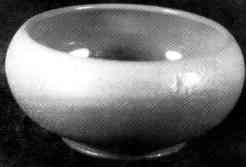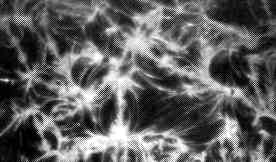Chipped Glass Treatment
by Bud Walker
Issue No. 293 - September 1997
Several years ago I bought an 8" Cambridge Azurite bowl with an
unusual textured finish. I was told by the dealer that the surface
 treatment was called "sponge acid etched."
treatment was called "sponge acid etched."
Azurite must have been one of Cambridge's most popular opaque colors as it is fairly easy to find today. This bowl differs in having the appearance of slightly crackled glass, except the crackling is only on the outside. I decided the bowl must be rare since the only other piece I've seen with this surface treatment is an Azurite vase in the National Cambridge Collectors' Museum.
You can imagine my surprise when I visited Dave Dorflinger, a fellow glass collector, and he brought out a large crystal bowl with the same finish. He hasn't been able to identify the maker, but it is definitely not Cambridge.
Knowing that Dave had grown up with glass, I asked if he had any idea how this type of finish was achieved. He said that this was an old way of decorating glass dating back to the late 1800s. First, the piece was etched in an acid bath or sandblasted to roughen the outer surface. Next, it would be painted with a substance known as fish or chip glue. After the glue had dried, the glass was heated in a kiln to 750 degrees. This caused the glue to explode or break off in chunks, taking a small amount of glass with it. The process could be repeated until the desired effect had been achieved.
Incidentally, fish or chip glue was used in making early furniture. It had to be heated before being applied, which gave off a terrible odor. If you take an old piece of furniture apart, you will notice that the glue comes off in chips or hard flakes.
When this "chipped" glass treatment is completed, the finish takes on the appearance of a snowflake pattern or frost on a window pane. Although the photographs do not fully capture the effect, you can see that this decorative treatment is quite beautiful.
After getting this information from Dave Dorflinger, I learned that Albert Christian Revi wrote about the chipped-glass process in American Art Glass Nouveau. Revi's book confirmed what Dave had said. In addition, Revi stated that the technique was patented in Germany by Carl Pieper in September 1883. The same process was later patented in the United States by Philip J. Handel of Handel and Company on November 22, 1904 (U.S. Patent No. 775,818).
Handel and Company were famous for their lamps, and many of them were reverse painted beneath a chippedglass surface. Other companies also followed this practice. Revi wrote, "The glue-chipping process ... was also used at the Steuben works. Mr. Carder always referred to this technique as 'glue chip."'
Returning to the Azurite bowl that started my search, I've learned
how this piece was decorated, and that it was called chipped glass,
glue-chip glass, or "Chipped Ice" (Betty Newbound's term in The Glass
Collector's Almanac). But was this surface treatment done at the
 Cambridge factory or did an independent decorator purchase the
blanks?
Cambridge factory or did an independent decorator purchase the
blanks?
If chipped glass was produced in any quantity at Cambridge, I think that more of it would be turning up. The fact that it is so hard to find leads me to believe that it was a product of a decorating company or an individual.
If anyone has additional information about this unusual glass, I would appreciate hearing from you. It's possible that a retired Cambridge glass worked may remember seeing this method in use.
[Permission was given to the author to have this article, which appeared in Glass Collector's Digest, printed here.]
